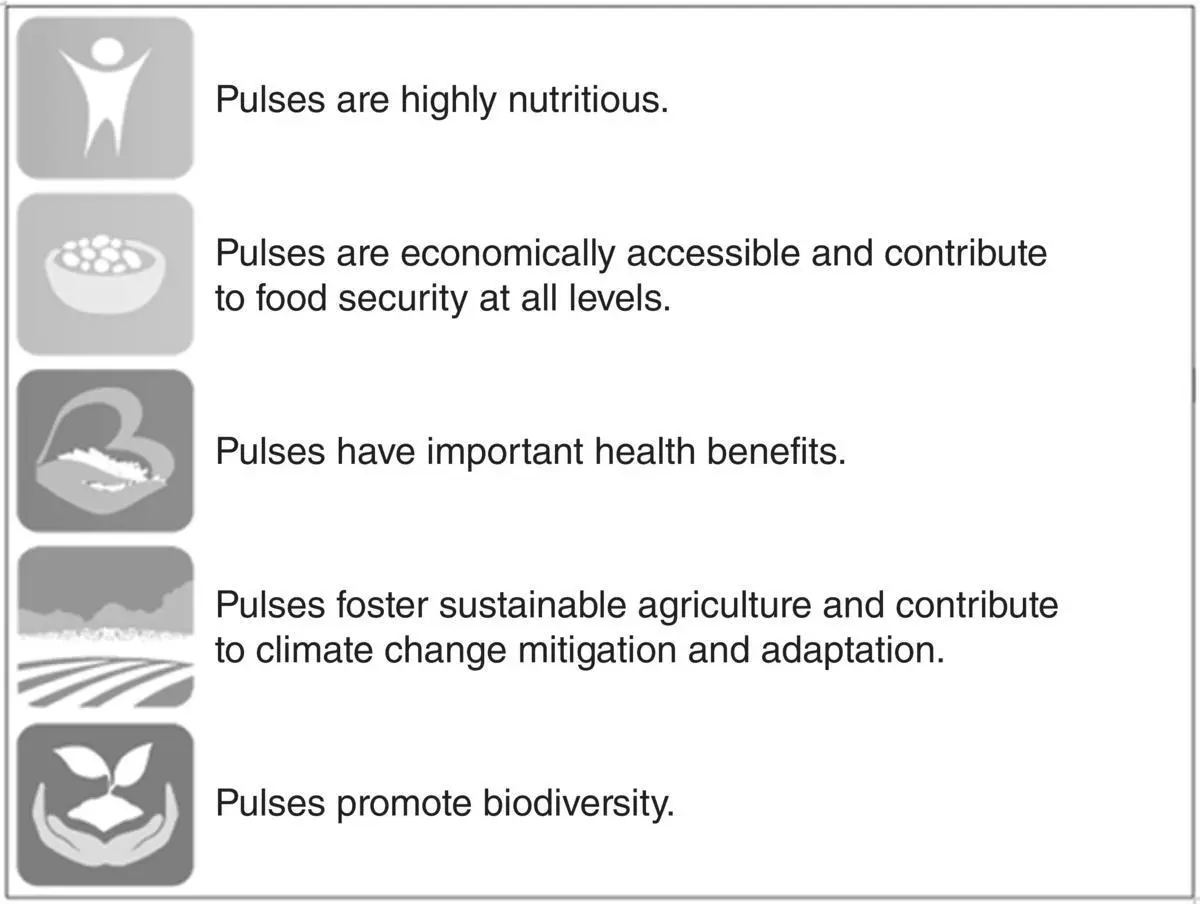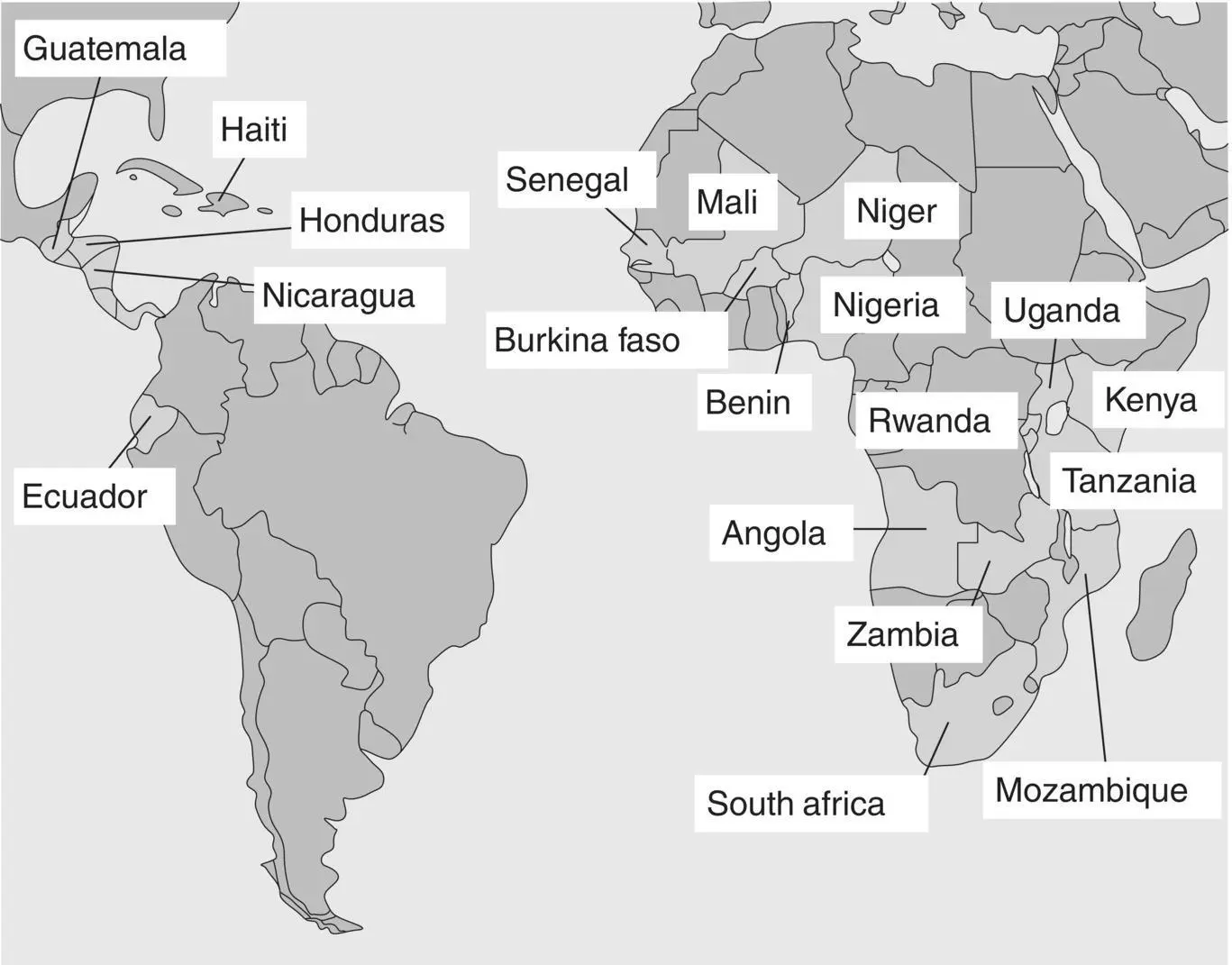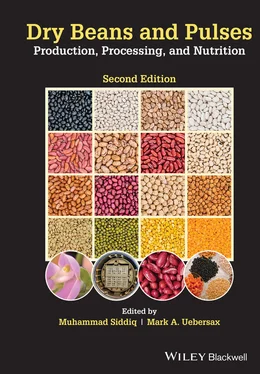Dry Beans and Pulses Production, Processing, and Nutrition
Здесь есть возможность читать онлайн «Dry Beans and Pulses Production, Processing, and Nutrition» — ознакомительный отрывок электронной книги совершенно бесплатно, а после прочтения отрывка купить полную версию. В некоторых случаях можно слушать аудио, скачать через торрент в формате fb2 и присутствует краткое содержание. Жанр: unrecognised, на английском языке. Описание произведения, (предисловие) а так же отзывы посетителей доступны на портале библиотеки ЛибКат.
- Название:Dry Beans and Pulses Production, Processing, and Nutrition
- Автор:
- Жанр:
- Год:неизвестен
- ISBN:нет данных
- Рейтинг книги:5 / 5. Голосов: 1
-
Избранное:Добавить в избранное
- Отзывы:
-
Ваша оценка:
- 100
- 1
- 2
- 3
- 4
- 5
Dry Beans and Pulses Production, Processing, and Nutrition: краткое содержание, описание и аннотация
Предлагаем к чтению аннотацию, описание, краткое содержание или предисловие (зависит от того, что написал сам автор книги «Dry Beans and Pulses Production, Processing, and Nutrition»). Если вы не нашли необходимую информацию о книге — напишите в комментариях, мы постараемся отыскать её.
The second edition of the most complete and authoritative reference on dry beans production, processing, and nutrition available Dry Beans and Pulses: Production, Processing, and Nutrition
Dry Beans and Pulses: Production, Processing, and Nutrition, Second Edition
Dry Beans and Pulses Production, Processing, and Nutrition — читать онлайн ознакомительный отрывок
Ниже представлен текст книги, разбитый по страницам. Система сохранения места последней прочитанной страницы, позволяет с удобством читать онлайн бесплатно книгу «Dry Beans and Pulses Production, Processing, and Nutrition», без необходимости каждый раз заново искать на чём Вы остановились. Поставьте закладку, и сможете в любой момент перейти на страницу, на которой закончили чтение.
Интервал:
Закладка:
In 2018, USAID‐funded Feed the Future Innovation Lab for Legume Systems Research , a five‐year research capacity building development program, was established at Michigan State University (FTF 2021). This current initiative builds on prior USAID‐funded research and training. Past programs include the Feed the Future Innovation Lab for Collaborative Research on Grain Legumes (2013–2017), which was an extension of the USAID Dry Grain Pulses Collaborative Research Support Program (Pulse CRSP) (2007–2012) and various earlier awards under Bean/Cowpea CRSP (1980–2007). This sustained federal support of research programs on grain legumes is due, in part, to important role legumes play in improving the livelihoods of smallholder farmers through income and farm productivity. The overall goals of the program project management are to increase sustainable and inclusive agricultural growth, strengthen the resilience of communities and agricultural and economic systems, and enhance the diets of individuals living in West and southern Africa (Nigeria, Niger, Mali, Ghana, Benin, Burkina Faso, Senegal, Mozambique, Malawi, and Zambia) and the United States (FTF 2021).

Fig. 1.8. Nutritious pulses for sustainable future – key messages.
Source: IYP (2016)
. 
Fig. 1.9. Countries with USAID’s Pulse CRSP supported projects.
Source: USAID (2012).
The Legume Systems Innovation Lab focuses on collaborative projects associated with two primary crops, common bean, and cowpea. These crops provide exceptional levels of nutrient dense staple foods. Further, it is fully recognized that legumes are especially important for women in many regions of the world, as they are often the producers, traders, and consumers of the crop. Collaborating international legume scientists and partner institutions enhance the global mission of improving livelihoods and nutritional impacts throughout legume value chains. Support of graduate student research training is critical to improving the research capacity of scientists in developing countries and is an important goal of this program (FTF 2021).
Dry beans in food aid programs
Dry beans are an important component of US foreign food aid programs. The USAID list the following beans and pulses as eligible for food aid programs in selected developing countries: black, blackeye, great northern, kidney (dark and light), navy, pink, pinto, small red, garbanzo, (chickpeas), lentils, and peas (USAID 2018). The targeted use of food aid programs and assistance with procurement and distribution of dry beans and/or partially prepared ingredients (flours, powders, meals, or extrudates) or fully prepared products (canned, precooked‐dehydrated, and extruded) will directly expand use in the most urgently needed populations. Utilization of prepared dry edible beans has consistently been advocated by both governmental and nongovernmental organizations (NGO). These nutrition programs are particularly important to infants and children. Dry edible beans are also frequently considered for applications in regions experiencing sustained crop failure (Siddiq and Uebersax 2012).
Several organizations within other nations provide significant levels of food aid to area of need, and most convey direct shipments of pulses because of the high nutrient density. These organizations/nations include Canadian International Development Platform (CIDP), UK Department for International Development (DFID), German Corporation for International Cooperation (GIZ); French Development Agency (AFD), Japan International Cooperation Agency (JICA), and Swedish International Development Cooperation (SIDA), to name a few.
SUMMARY
The trends in the production and consumption of legume‐based products are dynamic and are influenced by the challenges of global production. Increased use can be readily influenced by public policy, educational strategies, and industrial innovation. The evidence for health promoting aspects of legume‐based foods is strong and should receive more attention by consumers. In developed countries of Europe and North America, beans are generally prepared by commercial food processing operations and consumed as canned beans in brine or sauce. The market and overall consumption of beans and formulated bean products are expected to increase and to further segment as they are positioned as nutritionally rich and healthy foods. However, the development of high‐quality bean products in convenience foods categories such as dehydrated, frozen, and extruded formats appear to be an open opportunity.
The food industry, in cooperation with public research programs (universities and research centers) and other professional organizations, should focus efforts to incorporate dry beans and other pulses into innovative products that are economically viable, readily accessible to consumers, convenient to use, and of high culinary quality. The clearly recognized healthy attributes of beans deliverable in both subsistent and developed diets should be exploited for long‐term improvement in positive health outcomes. The factors limiting the consumption of dry beans in industrial economics may, in part, be attributable to an inadequate level of innovation for developing value‐added products adapted to modern consumer needs for convenience while specifically linked to high‐quality eating experiences. Opportunities to improve the use of dry beans and pulses require integration and expansion of public and private sector interventions that are socially and culturally appropriate.
REFERENCES
1 Angioi, S. A., Rau, D., Attene, G., Nanni, L., Bellucci, E., Logozzo, G., Negri, V., Zeuli, P.S. & Papa, R. (2010). Beans in Europe: origin and structure of the European landraces of Phaseolus vulgaris L. Theoretical and Applied Genetics 121: 829–843.
2 Anon. (2020). Bean consumption per capita. Available at https://www.helgilibrary.com/indicators/bean‐consumption‐per‐capita/(accessed December 30, 2020).
3 Bliss, F.A. (1993). Breeding common bean for improved nitrogen fixation. Plant and Soil 152: 71–79.
4 Boateng, J., Verghese, M., Walker, L.T. & Ogutu, S. (2008). Effect of processing on antioxidant content in selected dry beans (Phaseolus spp. L.). LWT − Food Science & Technology 41: 1541–1547.
5 Borget, M. (1992). Food Legumes. In: Tropical Agriculture (ed. R. Coste), pp. 16–96. London: CTA Macmillian Press.
6 Borbi, M.A., Dolan, K.D., Siddiq, M., Hooper, S. & Sami, A. (2020). Development and quality evaluation of banana‐rice‐bean porridge as weaning food for older infants and young children. Legume Science 2: p.e41.
7 Borchgrevink, C. (2012). Culinary Perspective of Dry Beans and Pulses. In: Dry Beans and Pulses Production, Processing and Nutrition, first edition (eds. M. Siddiq, M.A. Uebersax), pp. 313−334. Ames, IA: John Wiley & Sons.
8 Bouchenak, M. & Lamri‐Senhadji, M. (2013). Nutritional quality of legumes, and their role in cardiometabolic risk prevention: a review. Journal of Medicinal Food 16: 185–198.
9 Budhwar, S. & Chakraborty, M. (2020). Novel dietary and nutraceutical supplements from legumes. Sustainable Agriculture Reviews 45: 53–70.
10 Buttriss, J.L. & Stokes, C.S. (2008). Dietary fiber and health: an overview. Nutrition Bulletin 33: 186–200.
11 Chugh, C., Gosavi, G. & Kapoor, S. (2017). Biopharmaceutical aspects of legumes: A Review. Trends in Biosciences 10: 1970–1973.
Читать дальшеИнтервал:
Закладка:
Похожие книги на «Dry Beans and Pulses Production, Processing, and Nutrition»
Представляем Вашему вниманию похожие книги на «Dry Beans and Pulses Production, Processing, and Nutrition» списком для выбора. Мы отобрали схожую по названию и смыслу литературу в надежде предоставить читателям больше вариантов отыскать новые, интересные, ещё непрочитанные произведения.
Обсуждение, отзывы о книге «Dry Beans and Pulses Production, Processing, and Nutrition» и просто собственные мнения читателей. Оставьте ваши комментарии, напишите, что Вы думаете о произведении, его смысле или главных героях. Укажите что конкретно понравилось, а что нет, и почему Вы так считаете.












